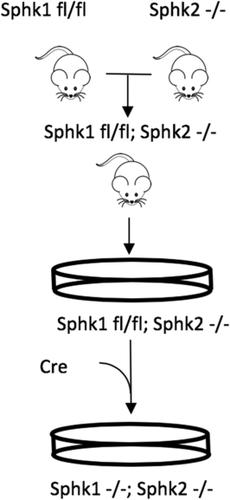当前位置:
X-MOL 学术
›
STEM CELLS
›
论文详情
Our official English website, www.x-mol.net, welcomes your
feedback! (Note: you will need to create a separate account there.)
Sphingosine Kinases Protect Murine ESCs from Sphingosine-induced Cell Cycle Arrest
STEM CELLS ( IF 4.0 ) Pub Date : 2020-01-29 , DOI: 10.1002/stem.3145 Suveg Pandey 1 , Kelly M Banks 1 , Ritu Kumar 1 , Andrew Kuo 2, 3 , Duancheng Wen 4 , Timothy Hla 2, 3 , Todd Evans 1
STEM CELLS ( IF 4.0 ) Pub Date : 2020-01-29 , DOI: 10.1002/stem.3145 Suveg Pandey 1 , Kelly M Banks 1 , Ritu Kumar 1 , Andrew Kuo 2, 3 , Duancheng Wen 4 , Timothy Hla 2, 3 , Todd Evans 1
Affiliation

|
Sphingosine‐1‐phosphate (S1P) is a bioactive lipid molecule regulating organogenesis, angiogenesis, cell proliferation, and apoptosis. S1P is generated by sphingosine kinases (SPHK1 and SPHK2) through the phosphorylation of ceramide‐derived sphingosine. Phenotypes caused by manipulating S1P metabolic enzymes and receptors suggested several possible functions for S1P in embryonic stem cells (ESCs), yet the mechanisms by which S1P and related sphingolipids act in ESCs are controversial. We designed a rigorous test to evaluate the requirement of S1P in murine ESCs by knocking out both Sphk1 and Sphk2 to create cells incapable of generating S1P. To accomplish this, we created lines mutant for Sphk2 and conditionally mutant (floxed) for Sphk1, allowing evaluation of ESCs that transition to double‐null state. The Sphk1/2‐null ESCs lack S1P and accumulate the precursor sphingosine. The double‐mutant cells fail to grow due to a marked cell cycle arrest at G2/M. Mutant cells activate expression of telomere elongation factor genes Zscan4, Tcstv1, and Tcstv3 and display longer telomeric repeats. Adding exogenous S1P to the medium had no impact, but the cell cycle arrest is partially alleviated by the expression of a ceramide synthase 2, which converts excess sphingosine into ceramide. The results indicate that sphingosine kinase activity is essential in mouse ESCs for limiting the accumulation of sphingosine that otherwise drives cell cycle arrest.
中文翻译:

鞘氨醇激酶保护鼠 ESC 免受鞘氨醇诱导的细胞周期阻滞
1-磷酸鞘氨醇 (S1P) 是一种生物活性脂质分子,可调节器官发生、血管生成、细胞增殖和细胞凋亡。S1P 由鞘氨醇激酶(SPHK1 和 SPHK2)通过神经酰胺衍生的鞘氨醇的磷酸化产生。由操纵 S1P 代谢酶和受体引起的表型表明 S1P 在胚胎干细胞 (ESC) 中具有几种可能的功能,但 S1P 和相关鞘脂在 ESC 中的作用机制存在争议。我们设计了一项严格的测试,通过敲除 Sphk1 和 Sphk2 来创建无法产生 S1P 的细胞,以评估小鼠 ESC 中 S1P 的需求。为了实现这一点,我们为 Sphk2 创建了突变系,为 Sphk1 创建了条件突变(floxed),允许评估过渡到双空状态的 ESC。Sphk1/2-null ESC 缺乏 S1P 并积累前体鞘氨醇。由于在 G2/M 时明显的细胞周期停滞,双突变细胞无法生长。突变细胞激活端粒延长因子基因 Zscan4、Tcstv1 和 Tcstv3 的表达,并显示出更长的端粒重复序列。向培养基中添加外源 S1P 没有影响,但通过神经酰胺合酶 2 的表达部分缓解了细胞周期停滞,神经酰胺合酶 2 将过量的鞘氨醇转化为神经酰胺。结果表明,鞘氨醇激酶活性在小鼠 ESC 中对于限制鞘氨醇的积累至关重要,否则会导致细胞周期停滞。和 Tcstv3 并显示更长的端粒重复。向培养基中添加外源 S1P 没有影响,但通过神经酰胺合酶 2 的表达部分缓解了细胞周期停滞,神经酰胺合酶 2 将过量的鞘氨醇转化为神经酰胺。结果表明,鞘氨醇激酶活性在小鼠 ESC 中对于限制鞘氨醇的积累至关重要,否则会导致细胞周期停滞。和 Tcstv3 并显示更长的端粒重复。向培养基中添加外源 S1P 没有影响,但通过神经酰胺合酶 2 的表达部分缓解了细胞周期停滞,神经酰胺合酶 2 将过量的鞘氨醇转化为神经酰胺。结果表明,鞘氨醇激酶活性在小鼠 ESC 中对于限制鞘氨醇的积累至关重要,否则会导致细胞周期停滞。
更新日期:2020-01-29
中文翻译:

鞘氨醇激酶保护鼠 ESC 免受鞘氨醇诱导的细胞周期阻滞
1-磷酸鞘氨醇 (S1P) 是一种生物活性脂质分子,可调节器官发生、血管生成、细胞增殖和细胞凋亡。S1P 由鞘氨醇激酶(SPHK1 和 SPHK2)通过神经酰胺衍生的鞘氨醇的磷酸化产生。由操纵 S1P 代谢酶和受体引起的表型表明 S1P 在胚胎干细胞 (ESC) 中具有几种可能的功能,但 S1P 和相关鞘脂在 ESC 中的作用机制存在争议。我们设计了一项严格的测试,通过敲除 Sphk1 和 Sphk2 来创建无法产生 S1P 的细胞,以评估小鼠 ESC 中 S1P 的需求。为了实现这一点,我们为 Sphk2 创建了突变系,为 Sphk1 创建了条件突变(floxed),允许评估过渡到双空状态的 ESC。Sphk1/2-null ESC 缺乏 S1P 并积累前体鞘氨醇。由于在 G2/M 时明显的细胞周期停滞,双突变细胞无法生长。突变细胞激活端粒延长因子基因 Zscan4、Tcstv1 和 Tcstv3 的表达,并显示出更长的端粒重复序列。向培养基中添加外源 S1P 没有影响,但通过神经酰胺合酶 2 的表达部分缓解了细胞周期停滞,神经酰胺合酶 2 将过量的鞘氨醇转化为神经酰胺。结果表明,鞘氨醇激酶活性在小鼠 ESC 中对于限制鞘氨醇的积累至关重要,否则会导致细胞周期停滞。和 Tcstv3 并显示更长的端粒重复。向培养基中添加外源 S1P 没有影响,但通过神经酰胺合酶 2 的表达部分缓解了细胞周期停滞,神经酰胺合酶 2 将过量的鞘氨醇转化为神经酰胺。结果表明,鞘氨醇激酶活性在小鼠 ESC 中对于限制鞘氨醇的积累至关重要,否则会导致细胞周期停滞。和 Tcstv3 并显示更长的端粒重复。向培养基中添加外源 S1P 没有影响,但通过神经酰胺合酶 2 的表达部分缓解了细胞周期停滞,神经酰胺合酶 2 将过量的鞘氨醇转化为神经酰胺。结果表明,鞘氨醇激酶活性在小鼠 ESC 中对于限制鞘氨醇的积累至关重要,否则会导致细胞周期停滞。











































 京公网安备 11010802027423号
京公网安备 11010802027423号